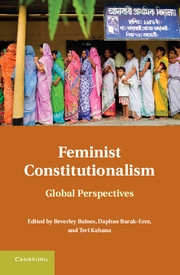Book contents
- Frontmatter
- Contents
- Foreword
- Contributors
- Introduction
- Part I Feminism as a Challenge to Constitutional Theory
- Part II Feminism and Judging
- Part III Feminism, Democracy, and Political Participation
- Part IV The Constitutionalism of Reproductive Rights
- Part V Women's Rights, Multiculturalism, and Diversity
- Part VI Women between Secularism and Religion
- Index
- References
Foreword
Published online by Cambridge University Press: 05 June 2012
- Frontmatter
- Contents
- Foreword
- Contributors
- Introduction
- Part I Feminism as a Challenge to Constitutional Theory
- Part II Feminism and Judging
- Part III Feminism, Democracy, and Political Participation
- Part IV The Constitutionalism of Reproductive Rights
- Part V Women's Rights, Multiculturalism, and Diversity
- Part VI Women between Secularism and Religion
- Index
- References
Summary
If feminism is what some of its purported academic adherents have made it over the last two decades or so, many of us have long been part of some other movement. The present volume goes far in reclaiming its promise as, in the words of Dean Daphne Barak-Erez, “a new interpretive perspective on human knowledge, including in the legal sphere,” as well as a tool for intervening in legal practice.
Women have not, in general, written or agreed to constitutions. Powerful men have written them a long time ago as if women did not exist, after wars in the waging and peacemaking of which women often did not actively participate, by foreign experts who assumed that liberalism was enough for women, by the accretion of practices in which women have had more or less say. More recently, women have had some voice in constitutive processes, but nowhere near half of the clout. With exceptions, dominant men have largely interpreted constitutions, and have overwhelmingly confined debates they deem authoritative on them, to terms they set.
- Type
- Chapter
- Information
- Feminist ConstitutionalismGlobal Perspectives, pp. ix - xiiPublisher: Cambridge University PressPrint publication year: 2012
References
- 3
- Cited by

